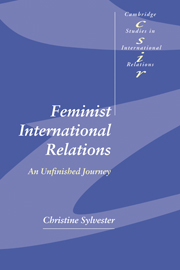Book contents
- Frontmatter
- Contents
- Acknowledgments
- Part I Introduction
- Part II Sightings
- Part III Sitings
- 8 The emperors' theories and transformations: looking at the field through feminist lenses
- 9 Feminists and realists view autonomy and obligation in international relations
- 10 Some dangers in merging feminist and peace projects
- 11 Gendered development imaginaries: shall we dance, Pygmalion?
- 12 Empathetic cooperation: a feminist method for IR
- Part IV Citings
- References
- Index
- CAMBRIDGE STUDIES IN INTERNATIONAL RELATIONS
12 - Empathetic cooperation: a feminist method for IR
Published online by Cambridge University Press: 22 September 2009
- Frontmatter
- Contents
- Acknowledgments
- Part I Introduction
- Part II Sightings
- Part III Sitings
- 8 The emperors' theories and transformations: looking at the field through feminist lenses
- 9 Feminists and realists view autonomy and obligation in international relations
- 10 Some dangers in merging feminist and peace projects
- 11 Gendered development imaginaries: shall we dance, Pygmalion?
- 12 Empathetic cooperation: a feminist method for IR
- Part IV Citings
- References
- Index
- CAMBRIDGE STUDIES IN INTERNATIONAL RELATIONS
Summary
As we end the section on sites that enable feminism within IR and IR within feminism, several themes and tributes from earlier essays gather in a final “empathetic” place. Elshtain's and Enloe's styles, the sources they use, and types of connections and arguments they make all assert themselves around me. Both scholars are good at ducking in and out of private and public spheres to find the transversal points, people, patterns of authority, and political outcomes that comprise international relations – and there is that constructivist theme again. As my journey continues, however, it also becomes clear to me that we must both enlarge and be scrupulously rigorous within our methodological repertory. Elshtain, Enloe, and Tickner were silent about the precise feminist approaches that informed their early research, although readers can see that Enloe and Tickner displayed feminist standpoint thinking while Women and War raised feminist postmodernist identity concerns. In the essays composing this section, I rah for specificity in between standpoint and postmodernist ways of siting feminist knowledge, wary of impaling women on the spears that thrust at both sites.
Standpoint feminism remains the approach that puts women front and center for a change – and I gulp in the sweet air around that – instead of dropping “her” in some back lot of social theory.
- Type
- Chapter
- Information
- Feminist International RelationsAn Unfinished Journey, pp. 242 - 264Publisher: Cambridge University PressPrint publication year: 2001



